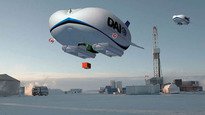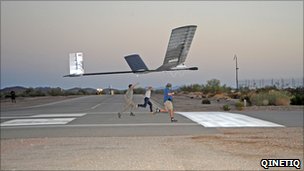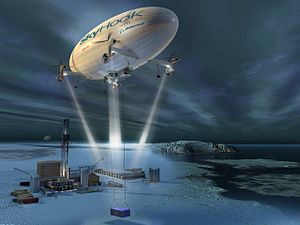Re Ian Bremmer 'Could third-party candidates upend the 2024 US election?' 3 April The current political movement in the USA…
Airships, Aviation and the Environment
Written by Diana Thebaud Nicholson // February 18, 2013 // Aviation & Aerospace, Environment & Energy // 1 Comment
See also Aviation & Shipping Emissions and Wednesday-Night.com
Déjà vu all over again – whatever happened to Skyhook International (see 2008)
Blimps for the far north
 (Discovery Air Innovations) An artist’s rendition of what an airship designed to fly in the Arctic would look like. The House of Commons transportation committee recommends in a recently released report launching a pilot project to test airships for remote communities.
(Discovery Air Innovations) An artist’s rendition of what an airship designed to fly in the Arctic would look like. The House of Commons transportation committee recommends in a recently released report launching a pilot project to test airships for remote communities.
Many remote communities and mining operations in Canada’s far north can only get needed supplies via aircraft, or over ice roads. However food and supplies via airplanes are extremely costly, and thanks to climate change, the season for ice roads is getting shorter and more dangerous.
Some people are now proposing to take another look at lighter-than-air type of craft.
A House of Commons committee is suggesting just that in a new report which was part of a larger study examining creative ways to deal with transportation issues in moving people and goods across the country.
Barry Prentice, a professor at the University of Manitoba and president of ISO Polar Airships, a research institute that promotes the use of the vehicles represented one of two groups proposing the use of airships. He noted that building proper roads to replace the diminishing ice road situation, would be astronomically costly.
Another intervenor, Discovery Air International said their efforts to develop a suitable airship would cost tens of millions, but that they are having difficulty raising money from the private sector.
The committee was wary of recommending spending public money on development, but did suggest investing in a pilot project through Public Works and Government Services to see if such a plan could work.
Meanwhile, another government department has decided to forge ahead with funding — Natural Resources announced $2.2 million Friday to support another company called Solar Ships.
2011
No orders, but Solar Impulse the coolest plane in Paris
The Paris Air Show was the tech geek’s fantasy. Entire runways and pavilions were stuffed with aircraft and gadgets whose technologies were billed as “next generation” or “game changing” or “revolutionary.” The geeks gathered by the hundreds or thousands to see concept airplanes, geared turbofan engines and night imaging systems that can tell how many steaks are cooking on your backyard grill from 5,000 metres.
Surprisingly, not many of the tech fans bothered to trundle to the far end of the aircraft display ramp to see the contents of an enormous white tent. Inside was a delicate bird with the wingspan of an Airbus A340 passenger jet, the weight of a car and the power of a scooter. It was an aircraft called the Solar Impulse and was arguably the most technologically advanced machine at the show.
The aircraft, as the name suggests, is powered entirely by the solar energy and is the first of its kind capable of flying night and day without using a drop of hydrocarbon fuel.
2010
24 December
 ‘Eternal’ solar plane’s records are confirmed
‘Eternal’ solar plane’s records are confirmed
The UK-built solar-powered Zephyr aeroplane has been confirmed as a record-breaker following its non-stop two-week flight earlier this year.
The world governing body for air sports records, the Federation Aeronautique Internationale (FAI), gave Zephyr three records including longest time aloft.
Built by defence technology company Qinetiq, the craft completed its two-week flight in the US in July.
The company sees applications in surveillance and communications.
The July feat led to Zephyr being dubbed the “eternal plane”.
“This aircraft can help track pirates off the Horn of Africa, alert the authorities about where and how fast forest fires are spreading, and ensure that soldiers’ communications remain unaffected when fighting in mountainous or hilly terrain,” said Qinetiq’s chief designer Chris Kelleher.
9 September
Steven Lightfoot: Technology as Magic…in an age of pessimism
(The Metropolitain) Solar Impulse, for all the wonder that it is, is about the best humanity is ever going to get out of a solar powered airplane. Any notion that the sun will ever power a heavier-than-air passenger-carrying aircraft significantly larger or faster than Solar Impulse is simply incorrect. The power required from the sun is simply not available in sufficient quantity, as we have shown. …
Humanity faces some very difficult challenges going forward, especially with regards to reducing emissions of all kinds, and building a more sustainable energy future. And while there are huge political elements to these challenges, there are also technical challenges.
I am personally against any effort to make the challenges we have look easy to solve, and the proposal of simplistic solutions to hugely integrated problems. When our citizens en masse start to expect unfeasible miracles from technology, and this gets translated into unrealistic policy from government bodies, we all lose. Investment money, a limited resource, is wasted on projects that ultimately do not deliver concrete benefits to society. And time is wasted.
There is much serious work to do to build a sustainable future. We need to embrace our enthusiasm for technical solutions with critical thinking so that the best, most realistic solutions are implemented.
We must not be lulled into thinking there are easy solutions to energy-related technical challenges, or sold exaggerated capabilities. There is too much at stake to get it wrong.
9 July
Solar-Powered Plane Flies for 26 Hours
The flight was the longest and highest by a piloted solar-powered craft, reaching an altitude of just over 28,000 feet above sea level at an average speed of 23 knots, or about 26 miles per hour. The plane, Solar Impulse, landed where it had taken off 26 hours and 9 minutes earlier, at Payerne, 30 miles southwest of the capital, Bern, after gliding and looping over the Jura Mountains, its 12,000 solar panels absorbing energy to keep its batteries charged when the sun went down.
8 April
Solar-Powered Plane Soars Above Switzerland
A solar-powered airplane designed to fly day and night without fuel or emissions successfully made its first test flight above the Swiss countryside on Wednesday.
The Solar Impulse, which has 12,000 solar cells built into its wings, is a prototype for an aircraft intended to fly around the world without fuel in 2012.
2009
12 October
Boeing Completes Major Design Milestone for SkyHook Heavy Lift Vehicle
The Boeing Company [NYSE: BA] and SkyHook International Inc. today announced that the design of the SkyHook Heavy Lift Vehicle (HLV) has reached the configuration freeze milestone, meaning the aircraft’s overall performance and layout have been established.
2008
8 July
 Boeing teams with Skyhook International to build heavy-lift rotorcraft
Boeing teams with Skyhook International to build heavy-lift rotorcraft
(Helicopters Magazine) The Boeing Company and SkyHook International Inc. today announced a teaming agreement to develop the JHL-40 (Jess Heavy Lifter), a new commercial heavy-lift rotorcraft designed to address the limitations and expense of transporting equipment and materials in remote regions. Boeing has received the first increment of a multiyear contract from SkyHook to develop the new aircraft (great photos).
The neutrally buoyant feature allows SkyHook to safely carry payloads unmatched by any rotorcraft in existence today. The helium-filled envelope is sized to support the weight of the vehicle and fuel without payload. With the empty weight of the aircraft supported by the envelope, the lift generated by four rotors is dedicated solely to lifting the payload, leaving the aircraft neutrally buoyant.
The SkyHook JHL-40 aircraft will be capable of lifting a 40-ton sling load and transporting it up to 200 miles without refueling in harsh environments such as the Canadian Arctic and Alaska. Currently, conventional land and water transportation methods in these undeveloped regions are inadequate, unreliable and costly. With its lifting capacity and range, the SkyHook JHL-40 aircraft changes that for a variety of industries around the world. (CBC) ‘Blimp on steroids’ designed to fly through remote skies
11 May

George Monbiot in The Guardian
If there is a God, he’s not green. Otherwise airships would take off
Many will cite the Hindenburg, but flying without harming the planet is possible. These craft are worth developing
Of all the charges levelled against environmentalists, perhaps the most unfair is the accusation that we are opposed to technological change. Most of the greens I know are fascinated by gadgets (sometimes to the exclusion of better solutions), while some of the people we confront seem terrified by new technologies, and react to them – witness the campaigns against windfarms – with irrational hostility.
But because environmentalists tend to have a feeling for material constraints, we recognise that solutions cannot be conjured out of thin air. In some cases they just don’t appear to exist. There are two reasons why we make such a fuss about flying. The first is that, even as governments promise to cut emissions, everywhere airports are expanding. In the UK, the government expects the number of airline passengers to rise from 228 million in 2005 to 480 million in 2030. Before long, there will scarcely be a patch of sky without a jet in it. The other is that there are no alternative means of propelling people through the air which are not more destructive than burning ordinary aviation fuel. Or so we think.
The airline companies prescribe two cures that are even worse than the disease. Even before they are deployed commercially in jets, biofuels are spreading hunger and deforestation. At first sight, hydrogen seems more promising. If it is produced by electrolysis using renewable electricity, it’s almost carbon free. The prohibitive issue is storage. Hydrogen contains just a quarter of the energy as the same volume of jet fuel (kerosene), which means that planes could fly long distances only if they were filled with gas, rather than passengers or cargo.
This means that if hydrogen planes are to fly commercially, they need much wider bodies than ordinary jetliners. According to the Royal Commission on Environmental Pollution, “the combination of larger drag and lower weight would require flight at higher altitudes” than planes fuelled by kerosene. A technology that is green at ground level becomes an environmental disaster in the stratosphere. Hydrogen’s great advantage – that it produces only water when it burns – turns into a major liability: in the stratosphere, water vapour is a powerful greenhouse gas. The commission estimates that hydrogen planes would exert a climate-changing effect “some 13 times larger than for a standard kerosene-fuelled subsonic aircraft”.
But there is another use for this gas, though I am aware that it will go down like a lead balloon with most of my readers. The word airship elicits a fixed reaction in almost everyone who hears it: “What about the Hindenburg?”. It’s as if, every time someone proposed travelling on a cruise ship, you were to ask: “But what about the Titanic?”. Yes, there was a spectacular disaster – 71 years ago. It has lodged in our minds because, like the Titanic, the Hindenburg was bigger and plusher than any craft built before it, and it was carrying rich and prominent people. The conflagration was witnessed by journalists and broadcast all over the world. It also became the technology’s funeral pyre: the Hindenburg was doomed long before it burnt, as airships were already being displaced by aeroplanes.
Though the designs have changed, their disadvantages have not disappeared. While a large commercial airliner cruises at about 900 kilometres per hour, the maximum speed of an airship is roughly 150kph. At an average speed of 130kph, the journey from London to New York would take 43 hours. Airships are more sensitive to wind than aeroplanes, which means that flights are more likely to be delayed. But they have one major advantage: the environmental cost could be reduced almost to zero.
Even when burning fossil fuels, the total climate-changing impact of an airship, according to researchers at the Tyndall Centre for Climate Change Research, is 80% to 90% smaller than that of ordinary aircraft. But the airship is also the only form of transport that can easily store hydrogen: you could inflate a hydrogen bladder inside the helium balloon. There might be a neat synergy here: one of the problems with airships is that they become lighter, and therefore harder to control, as the fuel is consumed. In this case they become heavier. Michael Stewart of the company World SkyCat suggests burning both gaseous and liquid hydrogen to keep the weight of the craft constant.
Airships fly much lower than planes, typically at about 4,000 feet, which means their emissions of water vapour have very little effect on temperature. If they were powered by hydrogen fuel cells, they would be almost silent, greatly reducing the effects for people on the ground. Though they are much slower than jets, the cabin can be built much wider, which means that travelling by airship would be rather like travelling by cruise ship, but at twice the speed and using a fraction of the fuel.
There are four small companies trying to get airships off the ground. Most of the new designs make use of aerodynamic lift as well as buoyancy (they are shaped like fat planes with stubby wings or tails), which means they are heavier and more stable than the old dirigibles and can land without help on the ground. They can alight on and take off from almost any flattish surface, including water. But all of them have a problem with flotation – of the financial rather than the physical kind. While the price of carbon stays low, companies have no financial incentive to switch to a different form of transport.
The only help governments are prepared to provide is some development funds for military applications: raising money for killing people is always easier than raising money to save them. For a few years the Pentagon took an interest in craft that could land anywhere and carry several hundred tonnes of equipment. Otherwise, like so many other promising green technologies, this proposal is losing height in a hostile market. All the companies promoting large commercial airships are concentrating on freight, especially in places that are poorly served by roads. The danger here is that, if they take off, they could displace not jet transport but freight shipping – in which case, if they burn diesel, they are likely to cause a net increase in carbon pollution.
Paradoxically, the other major constraint could be an environmental one. Airships are one of several green technologies that might be killed by a shortage of materials. A new generation of solar panels relies on gallium and indium, whose global supplies appear close to exhaustion. The price of platinum, which is used in catalytic converters, has tripled over the past five years. Beyond a few natural gasfields in Texas, economically viable supplies of helium are rare; even there they might be exhausted in 50 years at current rates of use, or much faster if airships take off. If there is a God, he isn’t green.
Is this proposal just a flight of fancy? Because airships feature in no official document, because they have not been considered by either government or major industry, I have no way of knowing. But like most greens I’m prepared to try almost anything, as long as it works. Can the same be said of our opponents?monbiot.com




One Comment on "Airships, Aviation and the Environment"
Hello,
This article was really interesting and well written.
Thank you